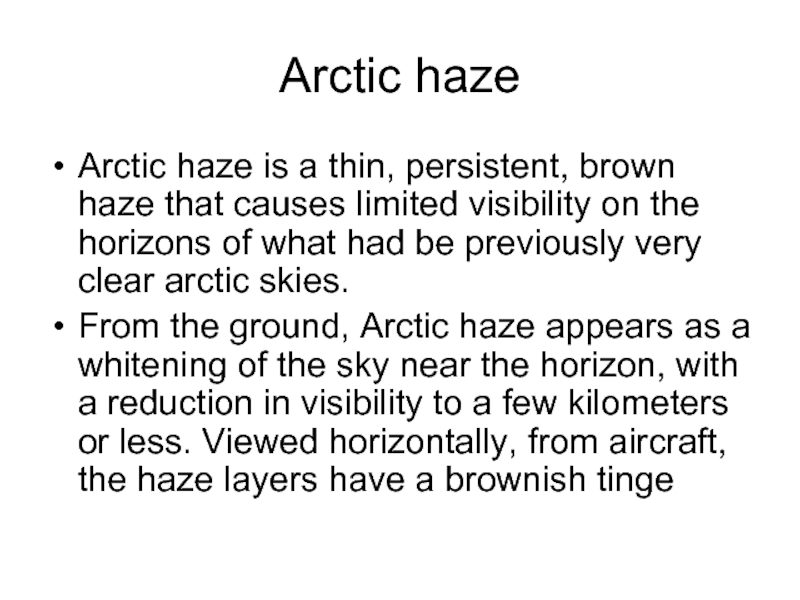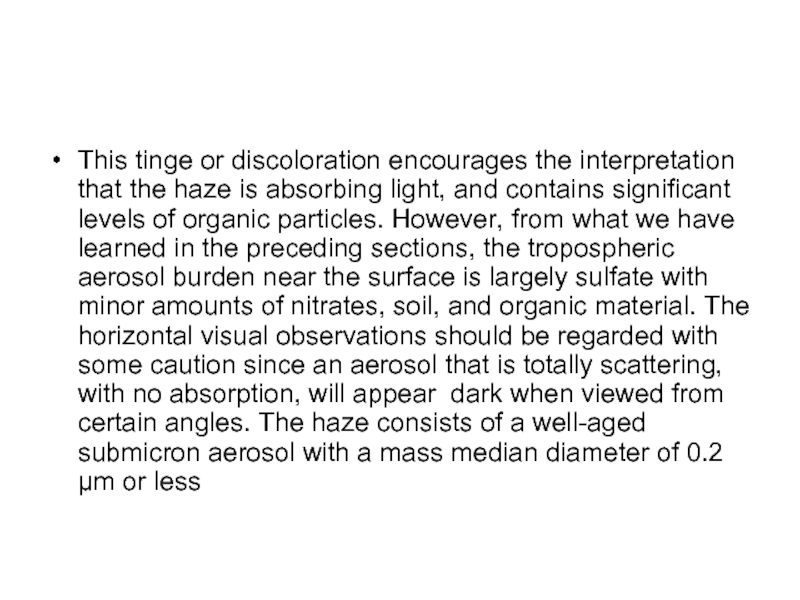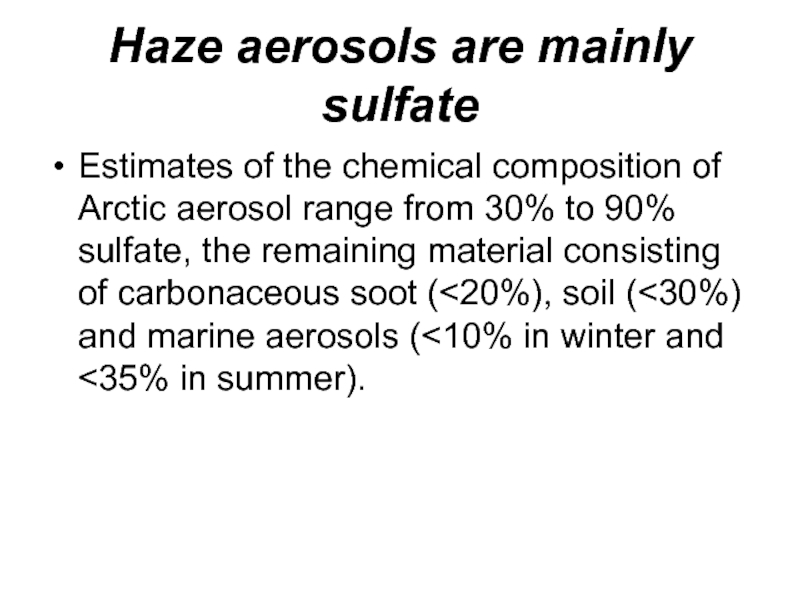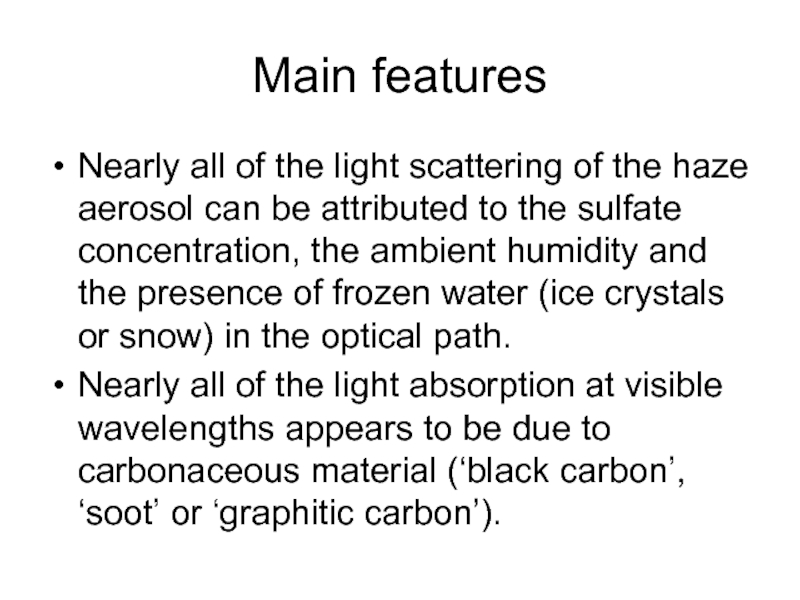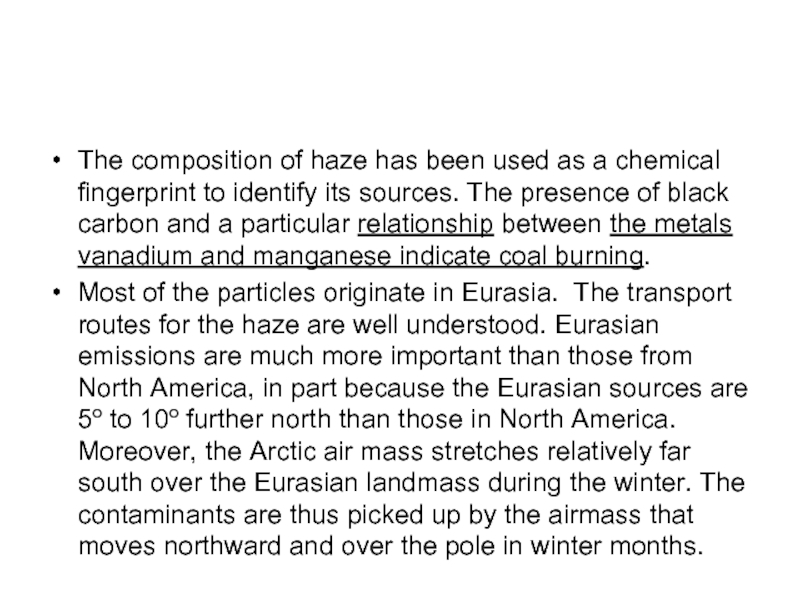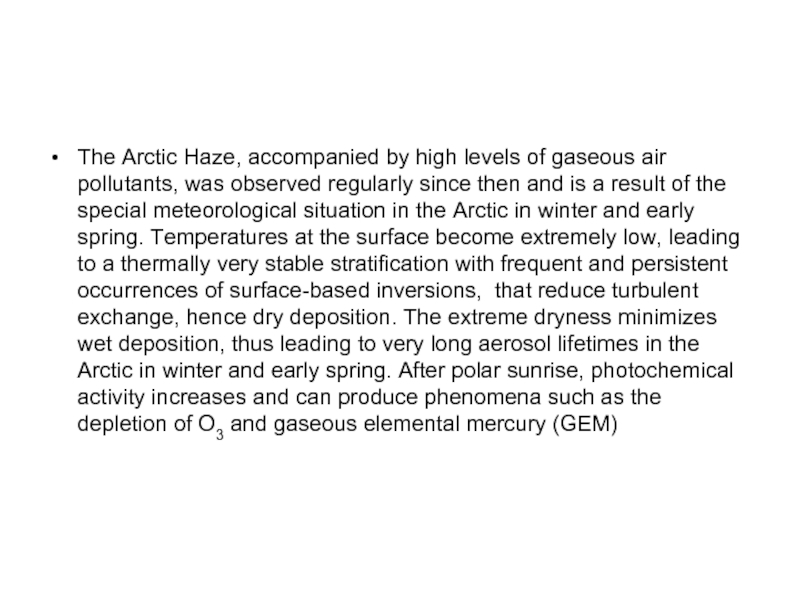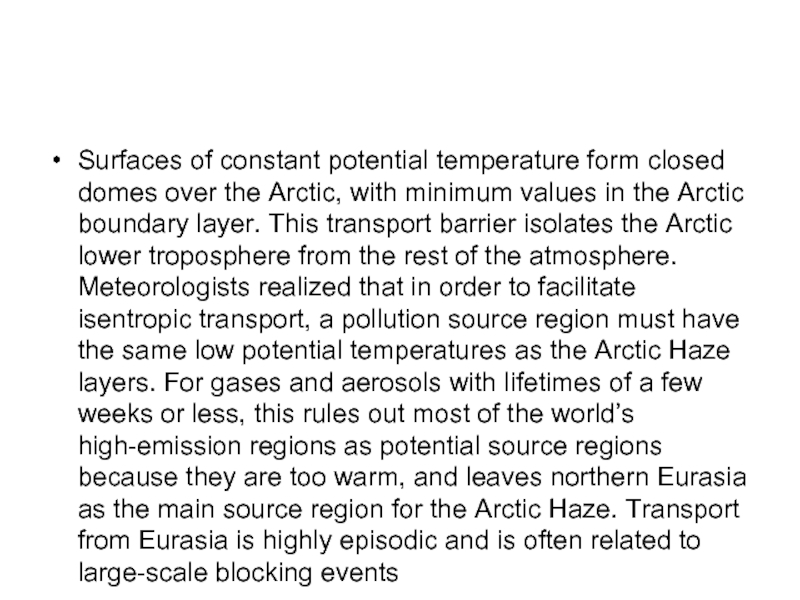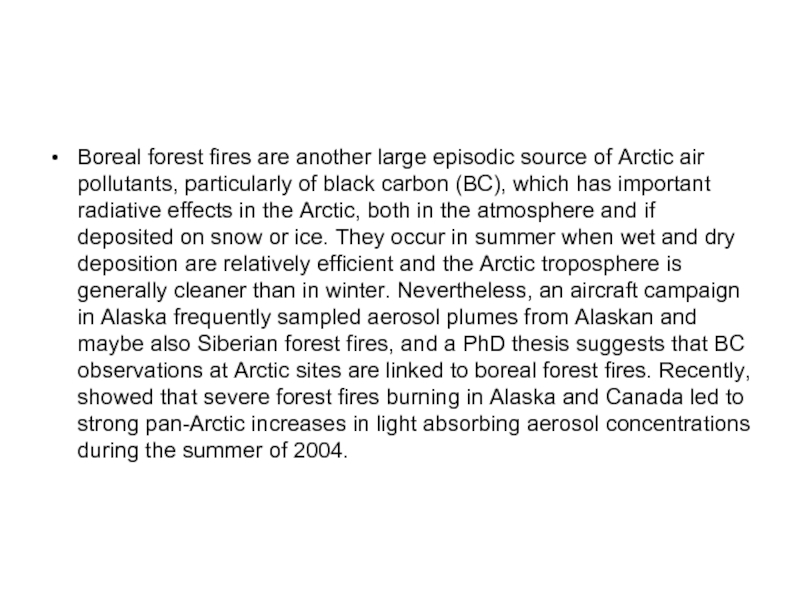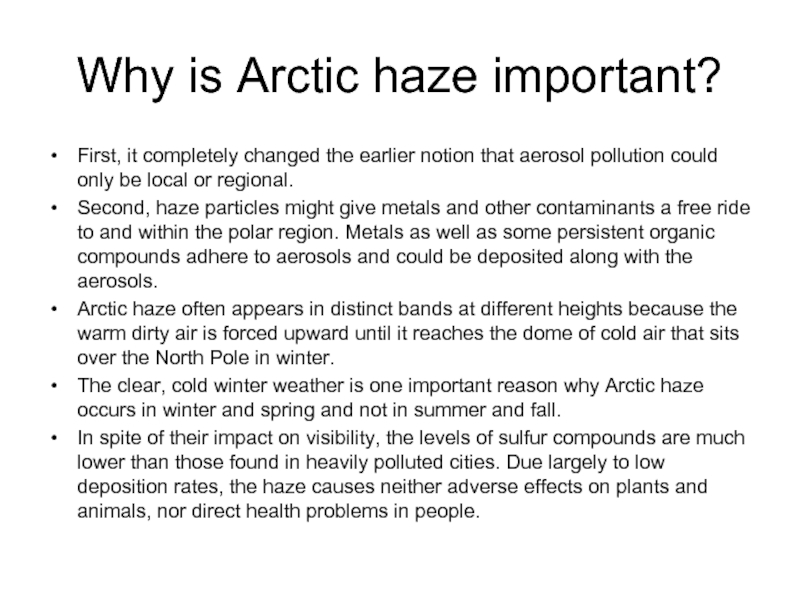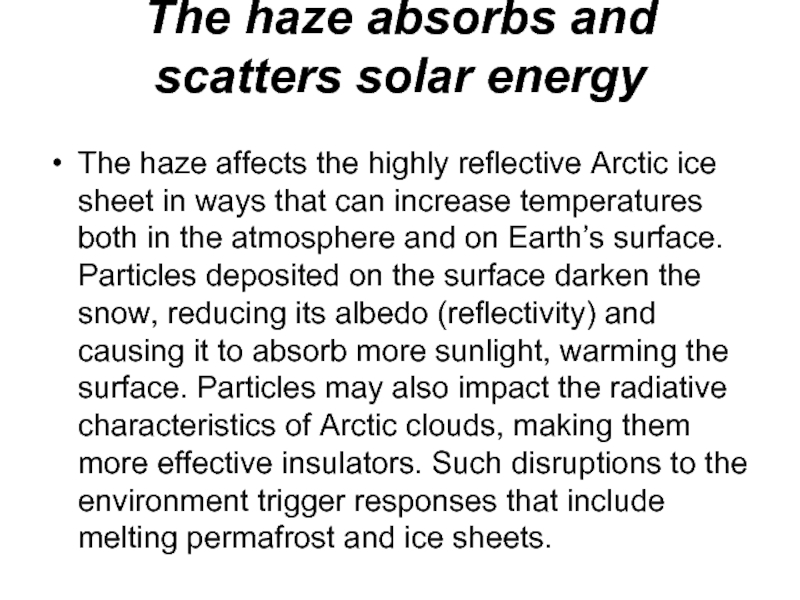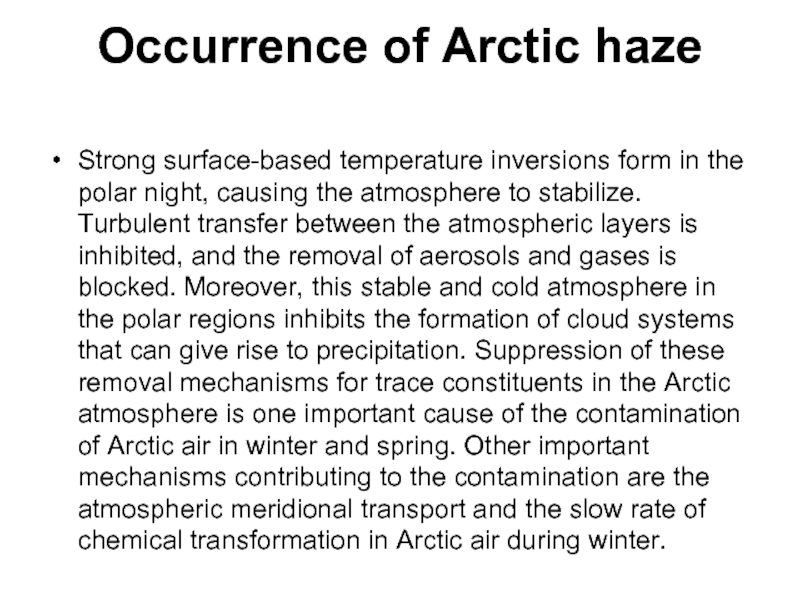- Главная
- Разное
- Дизайн
- Бизнес и предпринимательство
- Аналитика
- Образование
- Развлечения
- Красота и здоровье
- Финансы
- Государство
- Путешествия
- Спорт
- Недвижимость
- Армия
- Графика
- Культурология
- Еда и кулинария
- Лингвистика
- Английский язык
- Астрономия
- Алгебра
- Биология
- География
- Детские презентации
- Информатика
- История
- Литература
- Маркетинг
- Математика
- Медицина
- Менеджмент
- Музыка
- МХК
- Немецкий язык
- ОБЖ
- Обществознание
- Окружающий мир
- Педагогика
- Русский язык
- Технология
- Физика
- Философия
- Химия
- Шаблоны, картинки для презентаций
- Экология
- Экономика
- Юриспруденция
Arctic Haze презентация
Содержание
- 1. Arctic Haze
- 2. Arctic haze Arctic haze is a thin,
- 4. This tinge or discoloration encourages the
- 5. Haze aerosols are mainly sulfate Estimates of
- 6. Main features Nearly all of the light
- 7. The composition of haze has been
- 8. Vertical profile information on Arctic haze
- 9. The Arctic Haze, accompanied by high
- 10. Surfaces of constant potential temperature form
- 11. Boreal forest fires are another large
- 12. Why is Arctic haze important? First,
- 13. The haze absorbs and scatters solar energy
- 14. Occurrence of Arctic haze Strong surface-based
Слайд 2Arctic haze
Arctic haze is a thin, persistent, brown haze that causes
limited visibility on the horizons of what had be previously very clear arctic skies.
From the ground, Arctic haze appears as a whitening of the sky near the horizon, with a reduction in visibility to a few kilometers or less. Viewed horizontally, from aircraft, the haze layers have a brownish tinge
From the ground, Arctic haze appears as a whitening of the sky near the horizon, with a reduction in visibility to a few kilometers or less. Viewed horizontally, from aircraft, the haze layers have a brownish tinge
Слайд 4
This tinge or discoloration encourages the interpretation that the haze is
absorbing light, and contains significant levels of organic particles. However, from what we have learned in the preceding sections, the tropospheric aerosol burden near the surface is largely sulfate with minor amounts of nitrates, soil, and organic material. The horizontal visual observations should be regarded with some caution since an aerosol that is totally scattering, with no absorption, will appear dark when viewed from certain angles. The haze consists of a well-aged submicron aerosol with a mass median diameter of 0.2 μm or less
Слайд 5Haze aerosols are mainly sulfate
Estimates of the chemical composition of Arctic
aerosol range from 30% to 90% sulfate, the remaining material consisting of carbonaceous soot (<20%), soil (<30%) and marine aerosols (<10% in winter and <35% in summer).
Слайд 6Main features
Nearly all of the light scattering of the haze aerosol
can be attributed to the sulfate concentration, the ambient humidity and the presence of frozen water (ice crystals or snow) in the optical path.
Nearly all of the light absorption at visible wavelengths appears to be due to carbonaceous material (‘black carbon’, ‘soot’ or ‘graphitic carbon’).
Nearly all of the light absorption at visible wavelengths appears to be due to carbonaceous material (‘black carbon’, ‘soot’ or ‘graphitic carbon’).
Слайд 7
The composition of haze has been used as a chemical fingerprint
to identify its sources. The presence of black carbon and a particular relationship between the metals vanadium and manganese indicate coal burning.
Most of the particles originate in Eurasia. The transport routes for the haze are well understood. Eurasian emissions are much more important than those from North America, in part because the Eurasian sources are 5o to 10o further north than those in North America. Moreover, the Arctic air mass stretches relatively far south over the Eurasian landmass during the winter. The contaminants are thus picked up by the airmass that moves northward and over the pole in winter months.
Most of the particles originate in Eurasia. The transport routes for the haze are well understood. Eurasian emissions are much more important than those from North America, in part because the Eurasian sources are 5o to 10o further north than those in North America. Moreover, the Arctic air mass stretches relatively far south over the Eurasian landmass during the winter. The contaminants are thus picked up by the airmass that moves northward and over the pole in winter months.
Слайд 8
Vertical profile information on Arctic haze aerosols has been widely obtained
by lidar. In the vertical direction, the main mass of Arctic aerosols is limited primarily to the lowest five kilometers, peaking in the lowest two kilometers of the atmosphere, due to the strong inversions present in the Arctic.
Слайд 9
The Arctic Haze, accompanied by high levels of gaseous air pollutants,
was observed regularly since then and is a result of the special meteorological situation in the Arctic in winter and early spring. Temperatures at the surface become extremely low, leading to a thermally very stable stratification with frequent and persistent occurrences of surface-based inversions, that reduce turbulent exchange, hence dry deposition. The extreme dryness minimizes wet deposition, thus leading to very long aerosol lifetimes in the Arctic in winter and early spring. After polar sunrise, photochemical activity increases and can produce phenomena such as the depletion of O3 and gaseous elemental mercury (GEM)
Слайд 10
Surfaces of constant potential temperature form closed domes over the Arctic,
with minimum values in the Arctic boundary layer. This transport barrier isolates the Arctic lower troposphere from the rest of the atmosphere. Meteorologists realized that in order to facilitate isentropic transport, a pollution source region must have the same low potential temperatures as the Arctic Haze layers. For gases and aerosols with lifetimes of a few weeks or less, this rules out most of the world’s high-emission regions as potential source regions because they are too warm, and leaves northern Eurasia as the main source region for the Arctic Haze. Transport from Eurasia is highly episodic and is often related to large-scale blocking events
Слайд 11
Boreal forest fires are another large episodic source of Arctic air
pollutants, particularly of black carbon (BC), which has important radiative effects in the Arctic, both in the atmosphere and if deposited on snow or ice. They occur in summer when wet and dry deposition are relatively efficient and the Arctic troposphere is generally cleaner than in winter. Nevertheless, an aircraft campaign in Alaska frequently sampled aerosol plumes from Alaskan and maybe also Siberian forest fires, and a PhD thesis suggests that BC observations at Arctic sites are linked to boreal forest fires. Recently, showed that severe forest fires burning in Alaska and Canada led to strong pan-Arctic increases in light absorbing aerosol concentrations during the summer of 2004.
Слайд 12Why is Arctic haze important?
First, it completely changed the earlier
notion that aerosol pollution could only be local or regional.
Second, haze particles might give metals and other contaminants a free ride to and within the polar region. Metals as well as some persistent organic compounds adhere to aerosols and could be deposited along with the aerosols.
Arctic haze often appears in distinct bands at different heights because the warm dirty air is forced upward until it reaches the dome of cold air that sits over the North Pole in winter.
The clear, cold winter weather is one important reason why Arctic haze occurs in winter and spring and not in summer and fall.
In spite of their impact on visibility, the levels of sulfur compounds are much lower than those found in heavily polluted cities. Due largely to low deposition rates, the haze causes neither adverse effects on plants and animals, nor direct health problems in people.
Second, haze particles might give metals and other contaminants a free ride to and within the polar region. Metals as well as some persistent organic compounds adhere to aerosols and could be deposited along with the aerosols.
Arctic haze often appears in distinct bands at different heights because the warm dirty air is forced upward until it reaches the dome of cold air that sits over the North Pole in winter.
The clear, cold winter weather is one important reason why Arctic haze occurs in winter and spring and not in summer and fall.
In spite of their impact on visibility, the levels of sulfur compounds are much lower than those found in heavily polluted cities. Due largely to low deposition rates, the haze causes neither adverse effects on plants and animals, nor direct health problems in people.
Слайд 13The haze absorbs and scatters solar energy
The haze affects the highly
reflective Arctic ice sheet in ways that can increase temperatures both in the atmosphere and on Earth’s surface. Particles deposited on the surface darken the snow, reducing its albedo (reflectivity) and causing it to absorb more sunlight, warming the surface. Particles may also impact the radiative characteristics of Arctic clouds, making them more effective insulators. Such disruptions to the environment trigger responses that include melting permafrost and ice sheets.
Слайд 14Occurrence of Arctic haze
Strong surface-based temperature inversions form in the polar
night, causing the atmosphere to stabilize. Turbulent transfer between the atmospheric layers is inhibited, and the removal of aerosols and gases is blocked. Moreover, this stable and cold atmosphere in the polar regions inhibits the formation of cloud systems that can give rise to precipitation. Suppression of these removal mechanisms for trace constituents in the Arctic atmosphere is one important cause of the contamination of Arctic air in winter and spring. Other important mechanisms contributing to the contamination are the atmospheric meridional transport and the slow rate of chemical transformation in Arctic air during winter.

